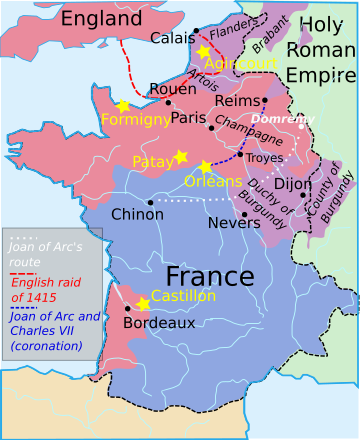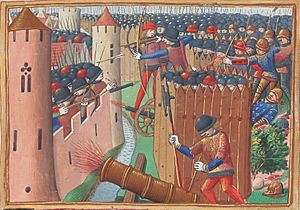Hundred Years' War, 1415–1453 facts for kids
The Lancastrian War was the third and final part of the Hundred Years' War. This long conflict was fought between England and France. It started in 1415 when King Henry V of England invaded Normandy. The war ended in 1453 when the English lost the city of Bordeaux.
This phase of the war is named after the House of Lancaster. This was the ruling family of England at the time, and King Henry V was a member of this family.
The first half of the war was mostly won by England. English victories, especially at the famous Battle of Agincourt, helped them take control of large parts of France. French leaders were also divided, which helped England. In 1420, the Treaty of Troyes was signed. This agreement said that the English king would marry the French princess Catherine. He would also become the ruler of France and the next king. This made England's claim to the French throne seem legal.
However, some French nobles did not accept this treaty. So, England still needed to fight to make their claims stick. King Henry V, and later his brother John, Duke of Bedford, led England to its greatest power in France. An English king was even crowned in Paris.
The second half of the war saw France fighting back strongly. French forces were inspired by heroes like Joan of Arc, La Hire, and the Count of Dunois. England also lost its main allies, the Dukes of Burgundy and Brittany. Charles VII of France was crowned king in Notre-Dame de Reims in 1429. After this, France slowly but surely took back its lands from England. In the end, the English were forced out of France. They lost all their lands on the European continent, except for the Pale of Calais. This last piece of land was later taken by the French in 1558.
The Battle of Castillon in 1453 was the very last battle of the Hundred Years' War. Even after this, France and England were officially at war until the Treaty of Picquigny in 1475. English (and later British) kings continued to claim the French throne until 1801. But they never seriously tried to take it again.
England's New War in France
Henry V of England believed he had a right to the French throne. He based his claim on his great-grandfather, Edward III of England. Edward's mother, Isabella of France, was a French princess. English law allowed inheritance through the female line. However, French law, called Salic law, did not allow women or their children to inherit the throne. The French court had already rejected this claim before. They chose Philip VI, who was related through the male line, instead.
When Henry V became king in 1413, he made peace at home. He settled disagreements with his family's old enemies. He also stopped a religious movement called the Lollards. In 1415, Henry V invaded France. His army successfully captured Harfleur. After this, many of his soldiers got sick. Henry's army then marched towards Calais to leave France.
French forces followed the English army, but they avoided a direct fight. They waited to gather more soldiers. Finally, the French army fought at Agincourt. This battle became the third major English victory of the Hundred Years' War. It was a huge disaster for the French.
After Agincourt, the two main French noble groups, the Armagnacs and the Burgundians, started talking about joining forces against England. Many important Armagnac leaders, like Charles, Duke of Orléans and Arthur de Richemont, were captured by the English. The Burgundians, led by John the Fearless, had not fought at Agincourt. But John's younger brothers died in that battle. Later, at a meeting between the French prince Dauphin Charles and John the Fearless, the Duke of Burgundy was killed by the Dauphin's followers. This event forced John the Fearless's son, Philip the Good, to make an alliance with the English.
The Treaty of Troyes
In 1419, Henry V made an official alliance with Philip the Good, the Duke of Burgundy. Philip had taken control of Paris after his father, John the Fearless, was killed. Together, they forced the French king, Charles VI, to sign the Treaty of Troyes.
This treaty stated that Henry would marry Charles's daughter, Catherine of Valois. It also said that Henry and his children would inherit the French throne. This meant the French prince, the Dauphin Charles, would not become king. Henry officially entered Paris later that year. The French government, called the Estates-General, approved the agreement.
Earlier in 1420, an English army led by the Earl of Salisbury attacked and destroyed a combined French and Scottish force near Fresnay. Reports say the French and Scottish lost 3,000 men. They also lost their camp and all its valuable items, including the Scottish treasury.
However, in 1421, a 4,000-strong English army was defeated by a larger French and Scottish army of 5,000 at the Battle of Baugé. During this battle, Thomas of Lancaster, 1st Duke of Clarence, who was King Henry V's brother, was killed.
English and Burgundian Power
Before he died, Henry V made plans for the war. He wanted his followers to keep fighting until the Treaty of Troyes was accepted across all of France. He also said that the Duke of Burgundy should be offered the role of regent (ruler) of France. If the Duke refused, Henry's brother, Bedford, should take the role. Henry stressed that the alliance with Burgundy must be kept strong. He also said that the Duke of Orléans and other prisoners should remain captive until his son grew up. There should be no peace treaty with the Dauphin unless Normandy was confirmed as English land.
Bedford followed his brother's wishes. The alliance with Burgundy stayed strong as long as Bedford was alive. After Henry V died young in 1422, his baby son was crowned King Henry VI of England and II of France. This happened almost at the same time as the death of Henry V's father-in-law, King Charles VI of France.
The Armagnacs, who supported the French prince, did not accept Henry VI as their king. They remained loyal to Charles VI's son, the Dauphin Charles. So, the war continued in central France.
In 1423, the Earl of Salisbury completely defeated another French and Scottish army at Cravant. This battle took place on the banks of the Yonne river. He bravely led his troops across the river and attacked a very strong enemy position. The Scottish soldiers suffered very heavy losses in this battle. The same year, the French won a battle at La Brossinière.
The next year, Bedford won a huge victory at Verneuil. This battle was so important that some called it a "second Agincourt." His army destroyed a French and Scottish army of about 16,000 men. This victory was not just because of the English longbows. New plate armor gave armored cavalry much better protection. The hot August weather meant English archers could not put their protective stakes into the ground. This led to archers on one side being pushed back. However, the English foot soldiers stood firm and fought hard. With help from archers attacking from the other side, they destroyed the allied army. The Scottish soldiers were surrounded and almost all of them were killed. About 6,500 soldiers died there, including all their commanders. After this, no large Scottish army landed in France again. The French also suffered greatly, as their leaders were killed and most of their soldiers were killed or scattered.
For the next five years, English power was at its highest. They controlled land from the Channel all the way to the Loire River. Only Orléans and Angers remained outside their control. Their territory stretched from Brittany in the west to Burgundy in the east. They achieved this with fewer and fewer soldiers.
Joan of Arc's Impact

Controlled by Henry VI of England Controlled by Philip III of Burgundy Controlled by Charles VII of France
★ Main battles --- Battle of Agincourt, 1415 --- Journey to Chinon, 1429 --- March to Reims, 1429
By 1428, the English were attacking Orléans. This was one of the strongest cities in Europe, with more cannons than the French had. However, one of the French cannons managed to kill the English commander, the Earl of Salisbury. The English army kept several small forts around the city. These forts were placed in areas where the French might try to bring supplies into Orléans.
In 1429, Joan of Arc convinced the Dauphin to send her to the siege. She said she had received messages from God telling her to drive out the English. She greatly improved the spirits of the French soldiers. They attacked the English forts, forcing the English to stop their siege. At the same time, the French king had improved his army. He also took advantage of the disagreements between England and its allies.
Inspired by Joan, the French captured several English strongholds along the Loire River. Then, they broke through English archers at the Patay. The English archers were led by John Fastolf and John Talbot. This victory helped Joan convince the Dauphin to march to Reims for his coronation as Charles VII.
Although Charles gained control of several other cities on his march to Reims and afterward, Joan never managed to capture Paris. Paris was just as well-defended as Orléans. Joan was captured on May 23, 1430, during the siege of Compiègne. She was captured by the Burgundian faction, who were allies of the English. Joan was then handed over to the English. She was put on trial by a church court led by Pierre Cauchon, who supported the English. Sadly, she died after the trial.
Burgundy Changes Sides
Bedford was the only person who kept Burgundy allied with England. Burgundy did not get along well with Bedford's younger brother, Gloucester. When Bedford died in 1435, the Burgundians felt they were no longer tied to the English alliance. They signed the Treaty of Arras, which gave Paris back to Charles VII of France.
Burgundy's loyalty remained uncertain, but they focused on expanding their own lands in the Low Countries. This left them with little energy to get involved in France. Bedford's death also removed the main leader on the English side. The end of the alliance with Burgundy showed that England's power in France was starting to decline.
The long periods of peace during the war also gave Charles VII time to improve his army and government. He replaced his old feudal armies with a more modern, professional army. This new army could use its larger numbers more effectively. Charles also made the French government more centralized. The French used a strategy similar to Du Guesclin's, avoiding big battles and slowly taking back town after town.
By 1449, the French had retaken Rouen. In 1450, the Count of Clermont and Arthur de Richemont (who would become Arthur III, Duke of Brittany) caught an English army trying to help Caen. They defeated the English at the Battle of Formigny. Richemont's forces attacked the English army from the side and rear just as they were about to defeat Clermont's army. The French then went on to capture Caen on July 6. They also captured Bordeaux and Bayonne in 1451.
Talbot tried to retake Guyenne. The local people initially welcomed him. However, his attempt was crushed by Jean Bureau and his cannons at the Battle of Castillon in 1453. Talbot had led a small English and Gascon force in a direct attack on a well-defended camp. This battle is considered the last battle of the Hundred Years' War.
See also


